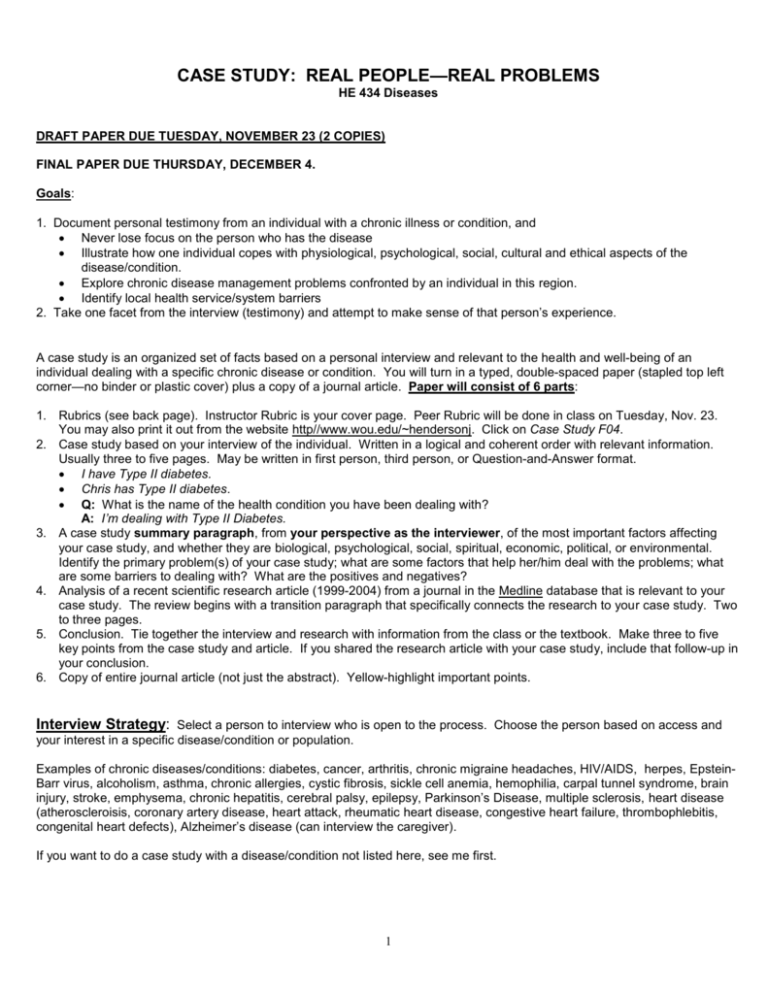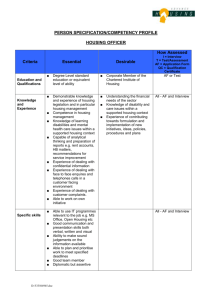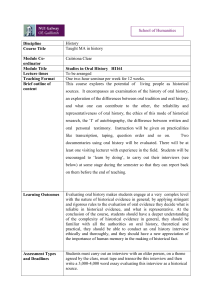CASE STUDY: REAL PEOPLE—REAL PROBLEMS
advertisement

CASE STUDY: REAL PEOPLE—REAL PROBLEMS HE 434 Diseases DRAFT PAPER DUE TUESDAY, NOVEMBER 23 (2 COPIES) FINAL PAPER DUE THURSDAY, DECEMBER 4. Goals: 1. Document personal testimony from an individual with a chronic illness or condition, and Never lose focus on the person who has the disease Illustrate how one individual copes with physiological, psychological, social, cultural and ethical aspects of the disease/condition. Explore chronic disease management problems confronted by an individual in this region. Identify local health service/system barriers 2. Take one facet from the interview (testimony) and attempt to make sense of that person’s experience. A case study is an organized set of facts based on a personal interview and relevant to the health and well-being of an individual dealing with a specific chronic disease or condition. You will turn in a typed, double-spaced paper (stapled top left corner—no binder or plastic cover) plus a copy of a journal article. Paper will consist of 6 parts: 1. Rubrics (see back page). Instructor Rubric is your cover page. Peer Rubric will be done in class on Tuesday, Nov. 23. You may also print it out from the website http//www.wou.edu/~hendersonj. Click on Case Study F04. 2. Case study based on your interview of the individual. Written in a logical and coherent order with relevant information. Usually three to five pages. May be written in first person, third person, or Question-and-Answer format. I have Type II diabetes. Chris has Type II diabetes. Q: What is the name of the health condition you have been dealing with? A: I’m dealing with Type II Diabetes. 3. A case study summary paragraph, from your perspective as the interviewer, of the most important factors affecting your case study, and whether they are biological, psychological, social, spiritual, economic, political, or environmental. Identify the primary problem(s) of your case study; what are some factors that help her/him deal with the problems; what are some barriers to dealing with? What are the positives and negatives? 4. Analysis of a recent scientific research article (1999-2004) from a journal in the Medline database that is relevant to your case study. The review begins with a transition paragraph that specifically connects the research to your case study. Two to three pages. 5. Conclusion. Tie together the interview and research with information from the class or the textbook. Make three to five key points from the case study and article. If you shared the research article with your case study, include that follow-up in your conclusion. 6. Copy of entire journal article (not just the abstract). Yellow-highlight important points. Interview Strategy: Select a person to interview who is open to the process. Choose the person based on access and your interest in a specific disease/condition or population. Examples of chronic diseases/conditions: diabetes, cancer, arthritis, chronic migraine headaches, HIV/AIDS, herpes, EpsteinBarr virus, alcoholism, asthma, chronic allergies, cystic fibrosis, sickle cell anemia, hemophilia, carpal tunnel syndrome, brain injury, stroke, emphysema, chronic hepatitis, cerebral palsy, epilepsy, Parkinson’s Disease, multiple sclerosis, heart disease (atheroscleroisis, coronary artery disease, heart attack, rheumatic heart disease, congestive heart failure, thrombophlebitis, congenital heart defects), Alzheimer’s disease (can interview the caregiver). If you want to do a case study with a disease/condition not listed here, see me first. 1 Ten possible interview topics and/or questions (you may be creative here—these are suggestions. Follow the lead of the person you are interviewing, as long as it is health related). 1. Hi. Thank you for giving me this opportunity to interview you—I appreciate your time, and am looking forward to learning from you. This will help me understand your health issues, and also fulfill a requirement for a course at WOU. I will write your experiences in a paper. If you want, I can use a fictitious name and will not disclose your personal identity. You do not have to answer any questions you feel uncomfortable with—please feel free to say “no comment” and we’ll move on to the next question. Do you have any questions for me before we begin? 2. OK, let’s begin with some basics. What is your age, gender, ethnicity, living location and job/student situation? What was the last grade you completed in school? What would you say is your income level: low, medium, high? (Remember you don’t have to answer if it’s too personal.) 3. What is the name of the health condition you have been dealing with, and how long have you been dealing with it? How were you diagnosed? Do you and your doctor agree on your condition? 4. How is the condition being treated? That is, what has your doctor or nurse told you to do? Are you following those guidelines/orders? 5. Are you dealing with the condition with something in addition to doctor’s orders? Some examples are vitamins/supplements, herbs, naturopathic medicine, support groups, yoga, spiritual healing, counseling, massage, acupuncture, hypnotism, etc.)? 6. How does the condition affect your quality of life and/or well being? How does it affect you on a day-to-day basis? For example: What are your physical symptoms, and how severe are they? Do you have any emotions related to the condition that affect you (positive emotions such as new appreciation for life, don’t-sweat-the-small-stuff attitude, etc., or negative emotions such as depression, fear, anxiety?) Has the condition affected your social life, (such as your work role or family role, marital relationship, support from family & friends, etc., awareness of social stigma of the condition)? Explain. Has there been an economic burden from the condition to you or your family? Explain. 7. Do you have health insurance? If yes, how satisfied are you with it, on a scale of 1 to 5, with “1” being extremely unsatisfied, and “5” being extremely satisfied? Why do you say that number? 8. How content are you with your doctor(s)? On a scale of 1 to 5, with “1” being extremely unsatisfied, and “5” being extremely satisfied, how satisfied are you with your doctor? Why do you say that number? 9. If you were to advise another person who had just found out they too have this condition, what would you tell them? 10. Overall, what is most helpful to you in dealing with this condition? What is the most important difficulty in dealing with this condition? *********************************************************************************************************************** Write the interview either as a story, report, or question-answer format. Example of a case study introduction paragraph written in first person: My name is Karen, and I’m 21 years old. I’m a third-year math education student with Rheumatoid Arthritis. On a good day I can attend my classes with no difficulty. On a bad day, I have a hard time gripping a pencil to write. I also tire easily, which my friends don’t seem to understand. I’m trying a new medication that for some reason gives me the side effect of not being able to concentrate. I have to see my doctor every other week, who lives in my hometown 100 miles away, which is a big hassle! I have to watch my stress level or everything gets worse. That’s life, I guess. Write a summary paragraph from your perspective as the interviewer. Identify primary issues, positives and negatives from the Biopsychosocial Model of Disease discussed in class (go back to your class notes). 2 Research journal articles in the Medline database that connect to the primary issues this person is dealing with. What is the most important information to this person? STRATEGY FOR FINDING A JOURNAL ARTICLE 1. From the WOU home page, connect to the Library and Media Services page. Click on “Journal Articles & Databases,” and “By Title.” Click on the letter “M” under the “Select by Title” category on the right. Click on Medline. 2. Enter keywords important to your case study. Click on “Rank by relevance” to make your search easier. 3. Click on articles that seem interesting. This will give you the abstract. Based on the abstracts, choose an article that is most relevant to your case study. Make sure it was published within the last 5 years. 4. If WOU subscribes to the journal, then find the article and make a Xerox copy of it. If WOU does not subscribe to the journal, you may request the article by clicking on “borrow this item from another library” (interlibrary loan). Usually you will get the article within a week via an email attachment. 5. NOTE: You will probably have to read the article several times before you understand it well enough to write a summary. TRANSITION PARAGRAPH. (write this after you analyze the research article). Connects case study with article Example: My case study, Mike, had epilepsy. Although he hasn’t had a seizure in two years, he continues to suffer from migraine headaches and fatigue. The keywords entered into Medline were: epilepsy and migraine headaches and fatigue. The article I chose tested the hypothesis that the co-morbidity of migraine headaches and epilepsy results from a shared genetic susceptibility to the two conditions. Interestingly, many of Mike’s family members suffered from migraine headaches, but none had epilepsy. Analyzing the Journal Article Below are some questions to help you write the analysis of the journal article. Your analysis should respond to every question below. Elaborate where needed for a detailed and interesting analysis of the article. 1. What is the title of the article and the journal? Who are the authors, and what are their credentials? Who is the target audience of the journal? 2. Is the article an empirical study (report of original research such as a scientific experiment or a survey), or a review article (one overall evaluation of many previously published articles into one article), or a theoretical article (presents a new theory based on a review of already existing research)? 3. What is the problem under investigation, and what is the purpose of the article? Was the problem under investigation supported with examples of previously published research, examples, anecdotes, narratives or examples? 4. Answer (a) or (b): (a) If the authors conducted their own investigation (empirical study), what were the methods used to conduct the investigation? What were the results? -or- (b) If the authors conducted a review article, what is the state of the current research: what are the main ideas, what are the consistencies and/or contradictions in the literature? 5. What are the authors’ results or conclusions? (What is the take-home message?) 6. What are the implications of the results and suggestions for the next step or steps? Any quotations from the article that particularly struck you? Concluding paragraph: 1. A re-statement of the high points from the case study interview and the research article. 2. A weaving together of threads of ideas/concepts/facts from the interview, research article, and class discussions. 3. If you shared the draft of the paper or the research article with your case study, write the follow-up discussion/comments here. 3 Example of concluding paragraph: In conclusion, Mary is one of the 20% of Americans who have been diagnosed with genital herpes. Although there is no cure, with the help of an anti-viral drug, Mary has had only one herpes outbreak in the past year. The recent article Recurrent Genital Herpes Treatments and Their Impact on Quality of Life demonstrated that anti-viral therapy improves quality of life in patients with frequent recurrences of genital herpes. This supports Mary’s experience that she has high quality of life, especially when she manages her stress. Mary found that high stress (such as final exam week) was a trigger for a herpes outbreak. As we discussed in class, stress can lower the function of the immune system. When the immune system is lowered, this gives the opportunity for the herpes virus to recur. Therefore stress management is an important psychological component of managing Mary’s condition. That psychological factors are important in the disease experience was also covered in class through the discussion of the Biopsychosocial Model of Disease. I followed up by sharing the research article with Mary, and she was very interested in the “Herpes Quality of Life Scale” and reading about others’ experiences. She said it was helpful to her to be able to talk openly about it in the interview, and she even thanked me for asking her to do the interview. I gained more respect for Mary after this interview—I had no idea she was impacted by herpes on a daily basis, whether or not she was having an outbreak. I learned that she is coping with a chronic condition by being an information-seeker, by being honest and open with potential sexual partners, and by practicing stress management. Final Note: At some point in the writing process, you need to make an appointment with the Writing Center (AP 401) and have someone review your paper for opportunities for improvement. You have someone advise you about the write-up of the interview, or look at the entire draft. The Writing Center will provide you with a validation slip after your consultation. The slip is to be attached to your final paper (see rubric). Reminder: you have to make an appointment ahead of time! Call 838-8286. 4






